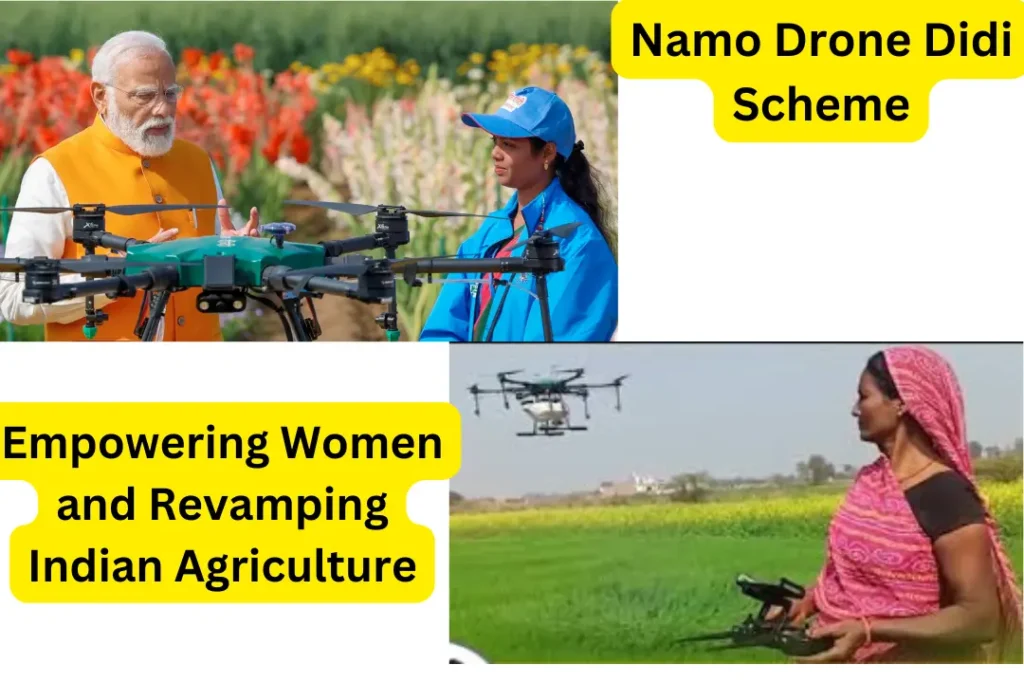
Namo Drone Didi Scheme
The newly elected Bharatiya Janata Party-led Indian government, in its cutting-edge Namo Drone Didi Scheme, has taken up a quest to empower women from rural India to enhance agricultural productivity by using drones. The Prime Minister of India, Narendra Modi, recently announced a policy whereby women coming under Self-Help Groups (SHGs) could become ‘drones’ to offer agriculture services like crop monitoring, spraying pesticides and collecting data. The government through this program aims to bring modernization in rural agriculture and enhance the socio-economic level of women, which in turn will facilitate general development in rural societies.
Table of Contents
Objectives and Vision of Namo Drone Didi Scheme
There are two prime objectives that the Namo Drone Didi Scheme focuses on: first, the introduction of modern technology in Indian agriculture; second, economic empowerment among the rural female population. This scheme will turn these women into “Drone Didis,” competent operators to eventually provide an essential service in the local farmers. This will give the benefit of technology in agriculture and open doors for actively participating women in rural economies. This initiative fits perfectly with the larger objectives of the “Atmanirbhar Bharat” (self-reliant India) vision of the Indian government, that is, self-sustaining, inclusive growth in the rural pockets.
Key Features and Implementation Strategies
The Namo Drone Didi Scheme has been planned with many features so that it can become an effective and sustainable scheme:
1. Access to Drone Technology: Drones are being provided to SHGs and can assist them in agriculture work, such as crop watching, pesticide spraying, and soil monitoring through the right procedure for farming, which saves more wastes and, in turn, maximizes greater crop productions.
2. Training Programmes for Women: The program considers the necessity of having ‘skilled’ operators and, thus, encompassed comprehensive modules about drone operation, maintenance, and service management that have been included for women. This trains them to handle the drones and gets them confident enough to stand alone.
3. Income Generation and Employment: This would generate incomes and employment amongst the women trained by offering their services to farmers in the area on fee-for-service. More and more farmers are taking up precision farming, which would also give these women steady incomes helping them improve their financial well-being and thus reinforce the economy of the countryside.
4. Government Support and Finance: Namo Drone Didi Scheme has particularly received a fund allocated by the government, and it is now the cost of drone including the train of the drone along with all the expenses during operations. SHGs which are not in financial crisis will also be able to participate.
Benefits of the Namo Drone Didi Scheme
The scheme benefits women, farmers, and agricultural boundaries in many ways:
– Increased Agricultural Productivity: The use of drones has given farmers actual data as well as timely information on crop health and levels of moistures within the soil or infestation with pests. Thus, it can result in better decisions, with improved yields and letting them conserve more water as well as fertilizers much better.
– Empowering women economically: The skill of commanding a drone for a fee empowers women as ‘skilled entrepreneurs,’ promotes gender equality and financial independence, and propels the “Drone Didis” from those communities to monetization, improving local economies in general.
– Cost Efficiency: The old ways of farming have the main cost in that a lot of force is required to labour and also the possibility of wasting inputs is very high. Drones use low-cost spraying of pesticides and soil analysis. Therefore, this makes them save on inputs and reduce environmental degradation.
– Sustainable Farming Practices: This might include sustainable farming practices pertaining to land monitoring over a certain period of time so that areas that are wasting resources or creating environmental damage might be seen and addressed. Since India looks for adopting friendly and sustainable forms of farming, this project is very much in line with such intentions.
Overcoming Barriers for the Success of the Scheme
Advantages of the Namo Drone Didi Scheme-The scheme has transformative benefits which are reliant upon overcoming certain barriers:
1. Technological Infrastructure: Deployment of drones requires a level of infrastructure that, for the most part, is deficit in rural areas. For the deployment and operation of drones to be successful, stable power supply and internet connection would be needed. If they are to operate drones, then the infrastructures become something essential to build within the remote areas.
2. Safety and Regulatory Issues: Drones would certainly have accompanying safety regulations, and there would be misuse issues, which would result in a set of legal issues. In order not to fall into accidents or violations, the women who enrolled under the scheme are required to know safety protocols, and legal guidelines.
3. Farmer Acceptance and Adoption: Many farmers would not adopt the new technologies since they will only be exposed to a limited extent or fear its potential risks. In this regard, the benefits of using drone services in agriculture should be exposed to many farmers through promotion and demonstrations in the fields.
4. Drone Maintenance and Repair: Maintenance of drones is needed regularly; however, at the rural locations, repair services and spares may be scarce. Teaching them simple troubleshooting and maintenance may prove a solution to reduce, in the long term, the number of days it goes idle.
Broader Developmental Effects on Rural Development and Gender Balance
The Namo Drone Didi Scheme has more implications regarding gender equality and rural development besides agricultural productivity:
– Empowerment of women: This scheme directly engages women in the agricultural economy and breaks traditional gender roles in creating better economic conditions. The participation in this scheme increases women’s confidence, technical skills, and financial independence to make them empowered.
– Empowerment of Local Economies: The program increases local economic activities because women are providing services that were not available prior to this. With an increased income level of SHGs, they can reinvest in the local businesses and, therefore, create a multiplier effect in the rural economy.
– Urban Migrant Reduction: Integrated development of the rural economies would reduce the tendency to migrate to the cities in quest of work, for more incomes generating opportunities are developed. The pressure on infrastructure within the cities would decrease, and the regions would see balanced growth.
International Cases and the Future
India has been learning lessons from initiatives all over the world. For example, Japan has well exploited drones in agriculture by the application of precise pesticides within the sector. Drones’ use in monitoring the vast extents of farmland and absorbing soil in the United States in order to ascertain its nature through technological usage is common. Such examples are being followed and applied through the right infrastructure and training in this case.
The Namo Drone Didi Scheme takes a step forward to reach every woman and see that the entire state of India is covered with the target that every district where agriculture is the main business should be reached. Advanced training in data analysis and maintenance of drones will empower more women to give more complex services to the farmers in the next phases of the scheme. This scheme is a model in the combinations of technological advancement with social empowerment and can be replicated in other developing countries to modernize their agricultural sectors.
Conclusion
The Namo Drone Didi Scheme is a landmark in that it uses this potential of drone technology to further several goals—modernizing Indian agriculture, enhancing gender equality, and boosting rural development. It will make women “Drone Didis” and elevate the economic status of rural women and bring out an efficient and sustainable agricultural system. It would be one such scheme, with good government support, infrastructure development, and proper legislation, making the Namo Drone Didi Scheme a new era of a technology-integrated agricultural system and setting it as a good example for other countries that are in a similar crisis.
This vision plan may, in fact, serve to be an example, showing the strength of innovation merged with inclusive community-driven development that shall usher in a future in which technology and empowerment go hand in hand.
Read more: Namo Drone Didi Scheme: Empowering Women and Revamping Indian AgriculturePradhan Mantri Janjatiya Unnat Gram Abhiyan: Concept and Development of Tribal Development in India
PM – Surya Ghar: Muft Bijli Yojana – A new energy initiative for rural India 2024




Hello, you used to write great, but the last several posts have been kinda boring… I miss your great writings. Past several posts are just a bit out of track! come on!